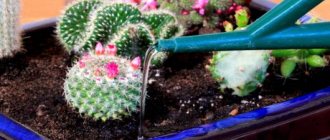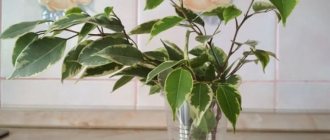How often to water a ficus
The need for water is individual for each plant. It depends on the following factors:
- age - the tree needs moisture more than cuttings;
- time of year - in spring and summer, ficus should be watered more often than in winter or autumn;
- substrate - light, permeable, dries faster than dense, spoiled or salty, absorbs water worse;
- volume and material of the pot - in plastic and glazed containers moisture is retained better than in “breathable” clay - watering will be more frequent there;
- how long ago the transplant was made - before rooting, the suction capacity of the shoots is reduced;
- depending on whether the ficus has completely entwined the earthen ball or has just begun to take root;
- size and number of leaves - the larger the area of the plate, the faster it evaporates moisture, the plant must be watered frequently;
- air temperature;
- how fast the flower grows;
- lighting intensity - under bright sun the ficus should be watered more often than on cloudy days;
- Are the crowns sprayed regularly?
A sick plant has a reduced ability to absorb moisture. Especially when the roots are damaged.
You need to water your ficus as needed, not on a schedule. In summer, water demand should be checked daily, in winter - once a week. But if the pot is located next to heating devices or the temperature in the room is too high - more often.
To find out whether the ficus needs moisture, you should immerse your finger in the substrate along the first phalanx:
- if it is wet, you need to leave the plant alone;
- dry - it's time to water;
- the finger does not enter the soil - the substrate needs to be replaced.
Large tubs should dry out by 3-4 cm. The soil there may be denser than that of young plants; you will have to use a stick rather than a finger.
In summer, lack of moisture is more dangerous, in winter – excess.
Various ficus plants are grown in pots; sometimes they differ not only in appearance. Plants should be cared for, including watered, taking into account their species characteristics.
Benjamin
Ficus Benjamin and its varieties (Kinky, Natasha, Daniel, Anastasia, etc.) need to be watered as the top layer of soil dries out. This is a fairly resistant variety. Binnendijka with long narrow leaves is slightly inferior to it in endurance. Short-term drying or accidental overwatering will not lead to loss of decorativeness or other negative consequences.
Most indoor flowers that are trees are the most durable. They may drop their leaves and become unsightly, but before the plant dies, the owners usually have enough time to correct the situation.
Rubber-bearing
The stem of this ficus does not become woody, and it needs to be watered especially carefully - if it starts to rot, there is nothing left to do but re-root the top. When it dries out, it loses leaves, and new ones do not appear in their place. The trunk will remain bald.
Elastica requires more moisture than Benjamin or Ali (Binnendijka). But the consequences of overwatering in this species are more serious.
Lyre-shaped
Ficus could be included in the previous paragraph, but its watering should not only be correct, but strictly controlled. This fantastically beautiful species has not received the popularity it deserves because it reacts to any disruption to the usual schedule by increasing or decreasing the leaves.
The size of successive plates may differ by 2-3 times, which looks even more ridiculous due to their original shape. Most often this happens with uneven watering.
It is impossible to calculate how many times a week you should moisturize Lyrata or create a schedule. It is necessary to constantly and carefully monitor the condition of the soil.
Bonsai
A low pot, cut roots, a small amount of substrate - all this determines frequent, often daily watering of ficuses formed as bonsai. The soil surface should never become completely dry.
Moisten the soil using a small-volume watering can with a long narrow spout through a fine sieve. Sometimes it is useful to water your bonsai using the dipping method. But they are left in the water for a very short time.
Microcarpa
How to water this ficus depends on the growing method:
- when planting in a standard pot, forming a regular tree, watering is the same as for Benjamin;
- if Ginseng is grown like a bonsai, which the species resembles without any tricks, and care should be appropriate.
Dwarf
This ficus loves frequent watering. Its stems are creeping, take root easily, and the sucking shoots are located close to the surface of the substrate. And they die from dryness.
Signs of improper watering
How to water dracaena for proper growing at home
Despite the fact that ficus is a fairly unpretentious plant, it is negatively affected by improper watering, regardless of whether it is a lack of liquid or, conversely, an abundance. Among the main signs that clearly make it clear that the plant needs to adjust the course of watering or water quality are:
- the gradual appearance of rot on the roots, trunk, and leaves of the plant. This sign is characterized by waterlogging; moisture stagnates in the pot. This can also cause fungal diseases;
- If the rubber ficus stops growing and leaves with yellowed edges can be seen on the lower parts of the plant, most likely the plant does not have enough liquid or useful microelements. In this case, it recommends fertilizing and increasing the number of waterings per week for a while.
Note! It is equally important to take care of adjusting watering depending on the air humidity and temperature of the room in which the ficus is located.
What are the consequences of improper watering?
If you water the plant, completely ignoring all the conditions, this can lead to the flower being affected by various diseases or even the death of the ficus. A similar attitude towards the plant is also manifested through the appearance of pests on the leaves. The most common problems associated with improper watering that does not correspond to the season or air humidity are:
- loss of leaves, appearance of yellow spots on both sides of the leaf blade of the flower;
- slow development of a dull shade on the leaf blades of the ficus and complete loss of the bright green shade.
If the rules are ignored for a long time, the ficus tree dries out completely.
For novice gardeners, it will be difficult to adjust the watering and fertilizing plan, so it is recommended to focus on the standard scheme. For experienced gardeners, it will not be difficult to determine when the plant exactly needs the addition of liquid based on the dryness of the soil.
What does improper care lead to?
How to water ficus
It is believed that for the rapid growth and well-being of indoor plants, it is better to water them with rainwater. This is only true for regions with good ecology. In the rest, you can use regular tap water. In order for the chlorine to come out, you should leave it in an open container overnight and then drain it from the sediment.
Well or artesian may be too hard, the impurities depend on the region. It is also recommended to defend it so that a crust does not form on the surface of the substrate.
It is better not to water ficus plants with boiled or purified water. It is considered “dead”, containing almost no oxygen and useful minerals.
The temperature of the liquid should be the same as in the room, or a little warmer. The cold causes shock to the roots of ficus trees.
Diseases and pests
Ficus can get sick if it is not watered regularly, gets cold, is under- or over-fed, or is provided with insufficient or excessive light.
Lumps on leaves
You are flooding the soil too much. The roots can rot, so they need to be removed from the pot, cut off the damaged parts, sprinkled with activated carbon powder and replanted in fresh soil. As a preventive measure, reduce watering.
Leaves wither and curl
This is a sign that the plant is freezing. Remove it from a cold windowsill and avoid drafts. Another possible reason is low air humidity - start spraying the ficus.
The tips of the leaves turn brown
This indicates a lack of moisture. Start spraying the leaves and remove the ficus from the radiators. You can also increase the air humidity in the room by placing a saucer of water next to the flower, hanging a damp towel on the radiator, or purchasing an air humidifier.
Thinning of young shoots
This occurs with a lack of light and feeding. Place the ficus on a well-lit windowsill or purchase a phytolamp for it, and also start using mineral fertilizers (Agricola in a dosage of 1 tsp per 2 liters of water) once every 2 weeks.
Yellowing of ficus benjamina leaves
This is a sign that you are flooding the plant and its roots are beginning to rot. Remove the plant from the pot, remove bad roots, remembering to treat the wounds with charcoal powder, and then replant it in new soil. As a preventative measure, reduce watering.
Leaves become soft
This happens when the plant freezes. Remove it from a cold windowsill or place it on a stand. When airing, take it to another room.
Spots on leaves
Yellow or brown spots are sunburn. Do not expose the plant to direct sunlight; install a shade on the southern windowsill.
Yellowing along the edges of the sheet
The plant lacks fertilizer. Add nitrogen fertilizing (Agricola at a dosage of 1 tsp per 2 liters of water) once every 14 days.
The foliage is drying
This happens in winter due to lack of lighting and air humidity. Provide the ficus with additional lighting using a phytolamp and increase the number of sprays, or install an air humidifier in the room.
You can also increase the humidity using old-fashioned methods: place a saucer with water and expanded clay near the pot or cover the radiator with a damp towel.
Botrytis
A white coating on the leaves will indicate its appearance. Remove the damage and treat the leaves with a fungicide (Fitosporin in a ratio of 1:20). If a single spraying does not help, repeat it after 10-12 days. It is also recommended to reduce watering during treatment.
Cercospora
Dark spots on the back surface of the foliage. Because of it, the plant may wither. Remove damage, treat with furatsilin: dilute 1 tablet in 100 ml of boiling water, cool to room temperature and spray on leaves. Remove the plant until it recovers.
Anthracnose
The edges of the leaves dry out and brown spots appear. Remove damage, treat with copper sulfate: 1 tsp. dilute in 2 liters of hot water, cool to room temperature, spray the leaves and water the soil. Place in quarantine for the duration of treatment. Repeated treatment is carried out after 1.5 - 3 weeks. It is also important to reduce watering during the treatment period.
Sooty fungus
It is a dark film resembling a soot coating. Because of it, the plant cannot breathe normally, which is why it begins to grow more slowly and weaken. Wash off the plaque with a damp cloth and give the plant a warm shower.
Remove the affected parts of the plant and treat all its parts, including the roots, with Aktara fungicide, diluting 1 g per 1.25 liters of water. To prevent fungal diseases, you can water the soil once a month with a weak solution of potassium permanganate.
Mealybug
White fluffy lumps on cuttings. The roots can also be affected, but this can only be known during transplantation or if the plant begins to wither.
Wash off in the shower, covering the soil with a bag, treat with insecticide: Confidor at the rate of 1 g per 1 liter of water, spray the foliage and spill the soil, repeat the procedure with Aktara in a week at a dosage of 1 g per 1 liter of water.
Shchitovka
Brown tubercles on the back surface of the leaves. Rinse off in the shower, covering the soil with a bag, treat the leaves on both sides with Actellik (2 ml per 2 liters of water) 3-4 times with an interval of 7 days. The drug is toxic, so it is advisable to carry out the treatment outdoors.
Spider mite
It appears as small red and brown dots crawling along leaves and branches. At later stages of damage, they are indicated by the appearance of cobwebs on the plant. Rinse off in the shower, covering the soil with a bag, treat the leaves on both sides with an insecticide: Actellik (2 ml per 2 liters of water), Aktara (4 g per 5 liters of water), Fitoverm (10 ml per 1 liter of water). Repeat the procedure three times every 10 days.
Aphid
Small green or black insects that attack the inside of leaves. Treat the plant with a soap solution three times during the week or spray the leaves on both sides with an insecticide: a solution of Bordeaux mixture (100 g per 10 liters of water, use no more than three times at weekly intervals), pyrethrum (2 g per 1 liter of water, treat 3 times). 4 times with a break of 5 days).
Thrips
They can be identified by shiny white spots on the outside of the foliage. The insects themselves settle on the underside and have bodies up to 1.5 mm long that are brown, black or gray.
Adults can be removed with a vacuum cleaner, and larvae with a cotton swab. It is advisable to transplant the flower into new soil, first disinfect the pot or purchase a new one. Can be treated with chemicals: Agravertine (10 ml per 1 liter of water). It is important to spray the entire plant.
Nematodes
These are invisible insects that attack plants, causing their leaves to stop developing, wither and become spotted. The chemicals used to control nematodes are toxic and should not be used indoors. The best solution is to throw the plant away.
If you still have the opportunity to treat the plant in the fresh air: dilute Actellik (2 ml per 2 liters of water) and spray the entire plant, and also immerse the roots in the solution. After this, you need to transplant it into new soil, having first disinfected the pot and the place where the ficus stood. This can be done with a solution of potassium permanganate, vinegar essence or soda-salt solution.
To avoid damage by this pest, the soil must be calcined before planting. To do this, pour the soil into a basin and pour boiling water over it, then place it on a baking sheet in a thin layer and heat in the oven for half an hour at a temperature of 70-90 degrees.
How to water plants correctly
There are several ways to moisten the soil. All of them are correct, but the simplest and most common is the first.
Top watering
The soil in the ficus pot should be loosened. It is recommended to use a watering can with a long thin spout. Water the substrate from above, slowly, until water begins to protrude through the drainage holes.
After 30 minutes, excess moisture is removed from the pan. In tub specimens, excess liquid can be collected using a rubber bulb. It is recommended to add it to your inventory for caring for indoor plants.
How to water a ficus in a tray
This method is usually used for Ficus pumila, which grows in a separate pot - wide and low. For other species it is recommended in winter.
Fill the pan with water. The liquid is gradually added as it is absorbed. When its volume stops decreasing and the surface of the substrate becomes wet, the remaining water is removed.
Ficus tubs cannot be watered this way. It will take so long to completely moisten the soil in large pots that it is better not to start.
Irrigation method
Dried ficuses, in which water does not linger in the substrate, but slips between the walls of the pot and the earthen lump, require immersion watering. In other cases, it is better not to use this method for ficuses.
A flower is placed in a bucket. Carefully add water so that it is 1-2 cm below the edge of the pot. When the surface of the substrate begins to shine from moisture, the ficus is removed, the liquid is allowed to drain, and returned to its original place.
Transfer
A plant up to 4 years old must be transplanted into a new pot every year in the spring. Select the diameter of the pots 2-3 cm larger each time.
An adult plant can be left in an old pot, partially replacing the soil in it when the roots become crowded. This can be understood by the roots peeking out of the drainage holes and the rapid drying out of the soil.
A ficus older than four years old requires transplanting into a new pot only if the roots have completely entwined the earthen ball and the substrate dries out quickly after watering.
We replant using the transshipment method. To do this, take the flower out of the old pot and replant it in new soil, without shaking the old substrate from the roots too much. Place a layer of expanded clay on the bottom of the flowerpot to ensure drainage.
Sprinkle with a fresh layer of soil. In hot weather, you can water the plant a little right away, otherwise wait a few days.
Important: after transplanting, remove fertilizing for a month.
Combination of fertilizing and watering
Between moistenings, the substrate in the flower pot should dry thoroughly. And fertilizing the ficus is done only on wet soil, at least half an hour after watering, when the water has been removed from the pan.
Even a weak fertilizer solution can burn roots in dry soil. And then gardeners receive a completely predictable “surprise” in the form of yellowing or falling leaves.
This may not happen, but it is better to feed the ficus in the traditional way: first watering, after 30 minutes - fertilizer.
Pruning and crown formation
Ficus is pruned to give it an aesthetic appearance and to rejuvenate it. In spring, shorten the branches, leaving 10-15 cm and thin out the crown, especially if the branches grow inside the bush.
You can also remove all side branches, forming one strong trunk. Treat cut stumps with potassium permanganate or activated carbon powder. It is also possible to weave the stems into a braid and create a ficus bonsai.
Braiding stems
This should be taken care of even at the stage of planting cuttings in a pot. Place 3-4 seedlings at once in one pot. They must be at least 13 cm long so that they can be braided.
Trim the side branches from the trunks and water the plant 10 hours before weaving begins. The density of the braid can be adjusted by inserting sticks into the gaps, which will need to be removed later, when the plant gets used to the new shape.
Tie the braided fragment with woolen thread to fix the branches in the desired position. As the ficus grows, add more braiding.
Sometimes, when the trunk reaches a great length, it is necessary to install a support so that the ficus does not fall to one side. To do this, place a stick in the pot and tie the stems to it in one or several places, depending on the height of the plant.
Compositions in bonsai style
To do this, it is important to immediately choose the right pot: it should be wide and low, like a tray, and always have holes in the bottom for drainage. The Exotic variety is best suited for forming a bonsai (it has developed roots, a beautiful trunk, small leaves, and it grows quickly).
- At the bottom we lay out a layer of drainage, a layer of river sand and a layer of soil.
- We trim the roots so that they are not crowded in the pot and cut the branches to a length of 15 cm.
- We plant it in a substrate, water it and place it in partial shade for 2 weeks.
- As it grows, we trim the main trunk, making a cut above the upper bud so that the ficus does not stretch upward, but grows to the sides.
- As the roots and trunk grow, once a year we transplant it into a wider pot. When the trunk reaches the desired thickness, replanting can be stopped.
- To form curved branches, we tie them to the trunk with supports. Gradually they will learn to grow in a certain direction without outside help, and the tying can be removed. It is also possible to use thin wire with insulation, which is wrapped around the barrels, fixing them in the desired position. When the ficus learns to grow as required, carefully cut the wire and remove it.
Important: the soil in low, wide pots dries out faster, so it is recommended to water and spray the ficus daily in small portions.
Spraying ficus
For the normal functioning of a crop at home, it is not enough to water correctly and regularly. Air humidity should be at least 50%, and preferably 70%. Otherwise, the leaves will turn yellow and fall off.
The care package must include daily spraying with warm soft water. Ficus plants especially need surgery in the hot summer and during the winter heating season, when the air in the house is dry.
In addition to spraying, you can increase humidity in different ways:
- place vessels with water between the pots;
- place a large number of plants close to each other;
- place expanded clay on a tray and water it regularly;
- place the pot in a flowerpot and fill the free space with wet acidic peat or sphagnum moss;
- buy an air humidifier or mini fountain.
It is very useful to give ficus plants a warm shower. Elastica leaves are regularly wiped with a clean, soft cloth dampened with water.
Not recommended:
- lay expanded clay, pebbles, decorative filling on the surface of the substrate - it looks beautiful, but it blocks the access of oxygen to the roots, does not allow moisture to evaporate, the soil in such pots often turns sour;
- Wipe the leaves of ficus with milk or special polishing agents - they clog the stomata, the plant looks very beautiful for a while, then it begins to wither.
Humidity and spraying
In summer, air humidity decreases, which affects the ficus. In the winter season, on the contrary, it increases, which also entails certain nuances that need to be taken into account when watering the plant.
The ficus itself prefers excessive air humidity, so to create a more favorable environment, periodic watering, regular spraying or rinsing the leaf plates in the shower are required.
Note! Since in many institutions, homes, schools and other buildings, ficus trees are installed to help clean the room from dust, a lot of small solid particles accumulate on their leaf blades. To give the ficus the opportunity to clean the room again, you need to regularly wipe the leaf plates on both sides with a damp sponge or swab.
When the humidity is above 30%, the plants do not need to be sprayed, but if it is below this indicator, then the procedure is carried out with warm or boiled water. The number of sprays is not limited.
Excess or lack of moisture (how to determine)
It is not always easy for an amateur gardener to understand from the appearance of a ficus why exactly it is experiencing discomfort: from an excess of moisture or from a lack of it. Indeed, in both cases, the plant will look approximately the same: a dull overall appearance, leaves without tone, losing their bright green hue and, ultimately, crumbling.
Lack of moisture for ficus
An external clue in favor of a lack of moisture in a ficus can be the condition of the leaves: it turns yellow, the bottom begins to fall off, dries out and turns brown at the edges, the top of the plant becomes withered, new castings either do not appear at all or grow small, often stopping their development.
Excess moisture for ficus
If moisture, on the contrary, is in excess, the foliage looks drooping, loses its elasticity, turns brown, but not at the edges, but at the base, and softer fragments appear on the leaf blade. The plant quite abruptly loses leaves, both upper and lower.
To notice a sharp overflow, you can smell the soil; it will have a strong stagnant odor.
The following unusual symptoms may occur:
- By all indicators, the plant is overdried, but it stands on the surface of the earth and does not absorb moisture; the problem may be that the substrate is compacted on the surface due to the formation of a salt crust; to solve it, you can loosen the top layer or replace it;
- There was a severe moisture deficit; Having discovered it, the owners begin to water intensively, but the plant still does not get hydrated; perhaps the substrate is so dry that it peels off from the walls of the flowerpot, so the liquid is not absorbed into it, pouring into the pan; in this case, it is best to immerse the plant in water so that the soil is saturated with moisture.
Reproduction of ficus benjamina at home
To grow a new ficus benjamina, disinfect the blade of a very sharp knife and carefully cut diagonally at a small semi-lignified branch of the plant. Rinse the cut under running water to remove the released milky juice. Then make a small longitudinal cut, as if splitting the stem of the cutting, and place it in a jar with clean water at room temperature. If the room is warm and there is enough sunlight, the roots will appear within a week or two. After this, plant the cutting in the substrate and care for it as usual.
The second, more complex method of propagating Ficus Benjamin is by layering. To do this, select a woody twig, make a transverse ring-shaped cut on it and cut off the bark in this place. Wrap the bare area in damp moss, wrap it with film and secure with thread. After some time, you will see roots emerging from under the moss. Cut the cuttings with a sharp knife and plant them in the ground.
Photo: waysi.ru
Geranium: home care, propagation and transplantation











